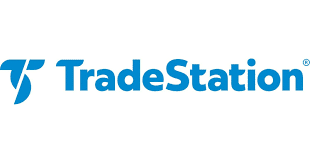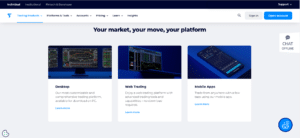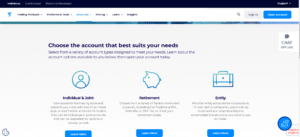
TradeStation Broker Review : Know its Features, Fees, Pros & Cons
TradeStation Overviews
TradeStation is a brokerage platform designed for active and professional traders, offering advanced tools for trading stocks, options, futures, ETFs, and cryptocurrencies. It features customizable charting, strategy back-testing, and proprietary tools like RadarScreen® and EasyLanguage®. TradeStation is regulated by the SEC, FINRA, and CFTC, ensuring secure trading. While ideal for experienced traders, it may present a learning curve for beginners.

Founded in 1982 by brothers William and Rafael Cruz, TradeStation has established itself as a prominent player in the online trading industry. Headquartered in Plantation, Florida, the company has expanded its presence with offices in key financial hubs, including New York, Chicago, London, and Amsterdam.
TradeStation is renowned for its advanced trading platform, which caters to active traders and institutional clients. The platform offers a comprehensive suite of tools for trading stocks, options, futures, and cryptocurrencies, emphasizing robust technical analysis capabilities. A standout feature is the proprietary EasyLanguage programming language, enabling traders to develop and back-test custom trading strategies without requiring extensive programming expertise.
Over the years, TradeStation has garnered multiple awards, reflecting its commitment to innovation and excellence. Notably, it was voted “Broker of the Year” in TradingView’s inaugural Broker Awards and has consistently received accolades for its platform technology and brokerage services.
In addition to its technological offerings, TradeStation places a strong emphasis on customer education and support. The company provides a range of educational resources, including webinars, tutorials, and the TradeStation Master Class, designed to enhance traders’ skills and knowledge. This commitment to education underscores TradeStation’s dedication to empowering its clients in making informed trading decisions.
TradeStation’s evolution from a software development firm to a comprehensive online brokerage highlights its adaptability and responsiveness to the changing needs of traders. By continually enhancing its platform and expanding its service offerings, TradeStation remains a reputable choice for traders seeking a sophisticated and user-friendly trading experience.
Pros and Cons
- Powerful platform with sophisticated charting and analysis tools.
- EasyLanguage programming for creating and back-testing trading strategies.
- Supports stocks, options, futures, and cryptocurrencies.
- Extensive educational content, including webinars, tutorials, and the TradeStation Master Class.
- Reliable execution and minimal downtime for active traders.
- Recognized for platform excellence and innovation.
- Monthly fees apply if minimum trading activity or account balance requirements aren't met.
- The advanced features can be overwhelming for beginners.
- Many assets are not commission-free unless specific conditions are met.
- Support hours are not 24/7, which may inconvenience some users.
- Services are restricted or unavailable in certain countries.
Is TradeStation Safe? Broker Regulations
TradeStation is a well-regulated broker, adhering to stringent industry standards to ensure the safety and security of its clients’ assets.
Regulatory Status
TradeStation Securities, Inc. operates as both a broker-dealer and a futures commission merchant (FCM). It is licensed by the U.S. Securities and Exchange Commission (SEC) and the Commodity Futures Trading Commission (CFTC). Additionally, TradeStation is a member of several key regulatory organizations, including:
- Financial Industry Regulatory Authority (FINRA): Oversees broker-dealers to ensure compliance with federal securities laws.
- Securities Investor Protection Corporation (SIPC): Provides insurance protection for securities customers up to $500,000, including $250,000 for cash claims.
- National Futures Association (NFA): The self-regulatory organization for the U.S. derivatives industry, including futures and forex.
These affiliations demonstrate TradeStation’s commitment to maintaining high regulatory standards.
Security Measures
TradeStation employs several measures to protect client funds and personal information:
- Account Protection: In addition to SIPC coverage, TradeStation has arranged for additional insurance through Lloyd’s of London, providing each account with up to $24.5 million in protection, subject to certain limits.
- Fund Segregation: Client funds are kept separate from the company’s own assets, ensuring that customer assets are protected even in the unlikely event of company insolvency.
- Two-Factor Authentication (2FA): To enhance account security, TradeStation offers two-factor authentication, requiring users to provide two forms of identification before accessing their accounts.
- Secure Socket Layer (SSL) Encryption: All data transmitted between clients and TradeStation’s servers is encrypted using SSL technology, safeguarding sensitive information from unauthorized access.
These security protocols are designed to provide clients with confidence that their accounts and personal information are well-protected.
- Financial Industry Regulatory Authority (FINRA)
- Securities Investor Protection Corporation (SIPC)
- National Futures Association (NFA)
What Can I Trade with TradeStation?
TradeStation offers a broad range of assets suitable for active traders. The platform is designed to cater to traders who want to access multiple markets through a single brokerage account.
Available Asset Classes:
- Stocks:
TradeStation provides access to U.S. equities, including major exchanges like the NYSE and NASDAQ. The platform supports advanced trading strategies and real-time data. - Options:
TradeStation allows options trading with features like real-time options chains and analytics tools. OptionStation Pro provides additional support for complex options strategies. - Futures:
TradeStation supports futures trading across a variety of asset classes, including indices, commodities, and interest rates. - Futures Options:
Users can trade options on futures with advanced tools and analytics. - ETFs:
Access to a wide range of exchange-traded funds to diversify portfolios. - Mutual Funds:
TradeStation offers a selection of mutual funds for long-term investment strategies. - Cryptocurrencies:
TradeStation Crypto offers trading of popular cryptocurrencies like Bitcoin, Ethereum, and others, providing a seamless experience for digital asset trading.
TradeStation’s robust platform supports advanced charting, real-time data, and custom strategies across these asset classes.
- Stocks
- Options
- Futures
- Futures Options
- ETFs
- Mutual Funds
- Cryptocurrencies
How to Trade with TradeStation?
Trading with TradeStation is streamlined for both beginners and advanced traders. Here’s a step-by-step guide to help you navigate the process:
Step 1: Log In to the Platform
- Access your account via the TradeStation Desktop, Web, or Mobile App.
Step 2: Explore Markets and Tools
- Use the TradeStation Analytics platform to explore markets and charting tools.
- Access customizable watchlists and real-time market data.
Step 3: Select Your Asset Class
- Choose from stocks, options, futures, ETFs, or cryptocurrencies to begin trading.
Step 4: Analyze with Tools
- Use advanced charting, indicators, and scanners like RadarScreen® and Matrix for analysis.
Step 5: Place a Trade
- Use order types like Market, Limit, Stop, or advanced options strategies.
- Enter the order details and confirm to execute the trade.
Step 6: Monitor and Manage Trades
- Track positions in real time with Portfolio Manager and Alerts.
Tools and Features:
- EasyLanguage for custom strategies.
- Simulated Trading for practice.
- TradeStation Crypto for seamless crypto trading.

How Can I Open TradeStation Account? A Simple Tutorial
How Can I Open a TradeStation Account? A Simple Tutorial
Opening a TradeStation account is straightforward. Here’s a step-by-step guide:
- Visit the Website: Go to TradeStation’s Account Page.
- Choose Account Type: Select from Individual, Joint, IRA, or Corporate accounts.
- Complete the Application:
- Provide personal information (name, address, SSN).
- Select trading preferences and funding options.
- Upload Documents: Submit identification (driver’s license or passport) and proof of address.
- Verify Identity: TradeStation may perform an identity check.
- Fund Your Account:
- Minimum deposits vary by account type.
- Fund via bank transfer, wire, or check.
- Account Approval: Approval typically takes 1-3 business days.
Start trading once your account is approved.
- Visit the Website
- Choose Account Type
- Complete the Application
- Upload Documents
- Verify Identity
- Fund Your Account
- Account Approval
TradeStation Charts and Analysis
TradeStation offers some of the most advanced charting and analysis tools available, making it an excellent choice for traders who rely on in-depth technical analysis. The platform’s charting features are customizable and cater to both novice and professional traders.
Chart Types
TradeStation supports a variety of chart types, including:
- Bar Charts
- Candlestick Charts
- Line Charts
- Renko, Kagi, and Point & Figure Charts for more specialized analysis.
Technical Indicators
With over 100 built-in indicators and the ability to create custom indicators using EasyLanguage, traders can analyze markets effectively. Popular indicators like moving averages, Bollinger Bands, and MACD are readily available.
Drawing Tools
TradeStation provides robust drawing tools such as:
- Trend lines
- Fibonacci retracements
- Channels
- Support and resistance levels
Timeframes
Charts can be customized to show multiple timeframes, including:
- Intraday (1-minute, 5-minute, 15-minute)
- Daily, Weekly, and Monthly timeframes
Advanced Features
- RadarScreen®: Real-time market scanner to track opportunities across hundreds of symbols.
- Matrix (Depth of Market): Combines order execution and market depth visualization.
- Strategy Back-Testing: Traders can back-test strategies using historical data to evaluate performance before executing trades.
Usability
TradeStation’s charting tools are accessible via:
- Desktop Platform: Full-featured experience.
- Web Platform: Simplified but powerful browser-based tools.
- Mobile App: On-the-go analysis and trading.
TradeStation Account Types
TradeStation offers various account types to meet the needs of different traders and investors. Here’s a detailed breakdown of the available options:
1. Individual Account
- For single users.
- Suitable for trading stocks, options, futures, and crypto.
- Standard features like real-time data, advanced charting, and analytics tools.
2. Joint Account
- Shared ownership between two individuals.
- Common for partners or spouses who wish to invest together.
3. Retirement Accounts (IRAs)
TradeStation supports several types of IRAs:
- Traditional IRA: Tax-deferred growth; pay taxes upon withdrawal.
- Roth IRA: Tax-free withdrawals in retirement.
- SEP IRA: Ideal for self-employed individuals or small business owners.
4. Entity Account
- For businesses, LLCs, and partnerships.
- Requires additional documentation, like articles of incorporation.
5. Margin Account
- Trade with borrowed funds to increase buying power.
- Subject to margin requirements and risk management rules.
6. Crypto Account
- Dedicated to trading cryptocurrencies.
- Seamless integration with TradeStation’s main platform.
- Supports popular assets like Bitcoin and Ethereum.
Features Across All Accounts
- Advanced Trading Tools: Charting, scanners, and back-testing.
- EasyLanguage: Create custom trading strategies.
- Educational Resources: Webinars, tutorials, and TradeStation Master Class.

Here is a detailed breakdown of TradeStation Account Types in a table format, as requested:
| Account Type | Description | Best For |
|---|---|---|
| Individual Account | Standard account for one person, supports all asset classes. | Solo traders and investors. |
| Joint Account | Shared account for two individuals, with equal ownership. | Partners or spouses investing together. |
| Retirement Accounts | Tax-advantaged IRAs (Traditional, Roth, SEP). | Long-term retirement savers. |
| Entity Account | For businesses, LLCs, partnerships; requires business documentation. | Corporate trading and investing. |
| Margin Account | Allows trading with borrowed funds; subject to margin requirements. | Traders seeking leverage for increased buying power. |
| Crypto Account | Dedicated account for trading cryptocurrencies like Bitcoin and Ethereum. | Crypto traders looking for platform integration. |
Do I Have Negative Balance Protection with This Broker?
TradeStation does not explicitly provide negative balance protection for all accounts, especially for those utilizing margin trading. Negative balance protection typically ensures that a trader cannot lose more than the funds available in their account. Since TradeStation caters primarily to active traders and professionals who often use margin, understanding the risks is critical.
How Margin Accounts Work
When you trade using a margin account, you borrow funds from TradeStation to increase your buying power. While this leverage can amplify profits, it also increases the risk of significant losses. In highly volatile markets, your losses can exceed your initial deposit, resulting in a negative balance.
Margin Call Policies
To mitigate this risk, TradeStation employs the following measures:
- Maintenance Margin Requirements:
Traders must maintain a minimum balance to keep positions open. If your equity falls below this requirement, TradeStation will issue a margin call, requiring you to deposit additional funds or liquidate positions. - Automatic Liquidation:
If you fail to meet a margin call, TradeStation may automatically liquidate your positions to prevent your account from going negative. However, this does not guarantee protection against all losses, particularly in fast-moving markets. - Risk Management Tools:
TradeStation provides tools like stop-loss orders and alerts to help manage risk. Utilizing these features can help minimize the chance of incurring a negative balance.
Considerations for Traders
- Futures and Options Traders: Due to the leveraged nature of futures and options, the risk of negative balances is higher. Ensure you understand the margin requirements and risks associated with these instruments.
- Cryptocurrency Trading: TradeStation Crypto does not offer margin trading, reducing the risk of a negative balance when trading digital assets.
Protect Yourself
To avoid a negative balance:
- Monitor Positions Closely: Regularly review your trades, especially if using margin.
- Use Stop-Loss Orders: Set stop-loss levels to limit potential losses.
- Maintain Adequate Equity: Keep sufficient funds in your account to cover potential losses.
TradeStation Deposits and Withdrawals
TradeStation offers a variety of methods for deposits and withdrawals, ensuring flexibility for traders. Here’s a detailed overview of the process, including transaction fees, processing times, and limits.
Deposit Methods
- Wire Transfer:
- Processing Time: 1 business day.
- Fees: TradeStation does not charge fees for incoming wires, but your bank may apply charges.
- Details: Available for both domestic and international deposits.
- ACH (Automated Clearing House) Transfer:
- Processing Time: 1-3 business days.
- Fees: No fees for ACH transfers.
- Details: U.S.-based bank accounts only.
- Limits: Daily and monthly limits may apply.
- Check Deposits:
- Processing Time: 5-7 business days.
- Fees: No fees for check deposits.
- Details: Checks must be drawn on a U.S.-based bank.
- Account Transfer (ACATS):
- Processing Time: 5-7 business days.
- Details: Transfer securities from another brokerage account.
Withdrawal Methods
- Wire Transfer:
- Processing Time: 1 business day.
- Fees: $25 per domestic wire; $35 per international wire.
- Limits: No set limits, but ensure sufficient funds are available.
- ACH Transfer:
- Processing Time: 1-3 business days.
- Fees: No fees.
- Limits: Daily limits may apply, typically up to $50,000.
- Check Withdrawal:
- Processing Time: 5-7 business days.
- Fees: No fees for standard mail; expedited delivery may incur charges.
Key Considerations
- Withdrawal Restrictions: Funds from recent deposits may be subject to a holding period before they can be withdrawn.
- International Users: International wire transfers are available, but additional fees and processing times apply.
- Crypto Accounts: For TradeStation Crypto, deposits and withdrawals are conducted in USD. Cryptocurrency transfers are not supported.
Support Service for Customer
TradeStation provides a comprehensive range of customer support options designed to help traders with their needs, ensuring timely assistance across multiple channels. Here’s an overview of the support services offered:
Support Channels
- Live Chat
- Available directly on the TradeStation website and trading platforms.
- Ideal for quick inquiries and real-time assistance.
- Phone Support
- General Support: Available Monday to Friday, 8 a.m. to 8 p.m. ET.
- Futures and Crypto Support: 24-hour availability during trading hours.
- Dedicated lines for different trading services ensure specialized assistance.
- Email Support
- Send detailed inquiries to the appropriate support email.
- Response times typically range from 1 to 2 business days.
- Knowledge Center
- Extensive self-help resources, including FAQs, tutorials, and platform guides.
- Accessible via the TradeStation Support Center on the website.
- Community Forums
- Connect with other traders and TradeStation experts.
- Participate in discussions and find answers to common issues.
Languages Supported
Support is primarily offered in English, with limited availability in other languages depending on the service channel.
Additional Resources
- Webinars and Tutorials: Enhance your trading skills through educational content.
- Platform Training: Personalized training sessions are available for new users.
Prohibited Countries: Where Can I Not Trade with this Broker?
TradeStation’s services are primarily available to U.S.-based traders and residents of a few select international regions. However, there are certain restrictions based on geographic and regulatory considerations.
Countries Where TradeStation is Restricted
TradeStation does not offer services in the following regions:
- Sanctioned Countries:
- Countries under U.S. economic sanctions, such as North Korea, Iran, Syria, and Cuba.
- Specific Jurisdictions:
- European Union (EU) countries due to specific regulatory frameworks and restrictions.
- United Kingdom: TradeStation’s offerings are limited, and services may not be fully available.
- Other Restricted Regions:
- Certain countries in the Middle East, Africa, and Asia due to local financial regulations.
Crypto Trading Restrictions
TradeStation Crypto is available only to residents of certain U.S. states. Crypto trading may not be available in states where cryptocurrency regulations are restrictive.
Why These Restrictions Exist
TradeStation complies with regulations set forth by U.S. authorities such as:
- SEC (Securities and Exchange Commission)
- CFTC (Commodity Futures Trading Commission)
- FINRA (Financial Industry Regulatory Authority)
Special Offers for Customers
TradeStation offers a range of promotions and incentives designed to provide value for new and existing customers. These offers are aimed at enhancing trading experiences and reducing costs.
1. New Account Promotions
- Cash Bonus Offers: TradeStation frequently offers cash bonuses for opening and funding new accounts. Bonuses vary based on the amount deposited and traded.
- Commission Rebates: New customers may qualify for rebates on trading commissions during their first few months.
2. Crypto Promotions
- Crypto Trading Credits: New TradeStation Crypto users may receive trading credits when they open and fund a crypto account.
- Referral Bonuses: Existing users can earn rewards by referring new crypto traders to the platform.
3. Free Market Data
- Depending on your trading activity, TradeStation offers free access to real-time market data for stocks, options, and futures.
4. Educational Offers
- Free Master Class Access: New users may get free access to TradeStation’s Master Class, which includes in-depth tutorials and platform training.
- Webinar Series: Exclusive access to trading webinars and strategy sessions.
5. Active Trader Incentives
- Reduced Commissions: Active traders who meet certain volume thresholds can benefit from discounted commissions and fees.
Note: Promotions and offers are subject to terms and conditions. They may change periodically, so it’s best to check TradeStation’s Special Offers Page for the latest deals.
TradeStation Review Conclusion
TradeStation has solidified its reputation as a leading broker for active and professional traders, thanks to its powerful trading platforms, advanced tools, and extensive asset offerings. The platform’s strength lies in its ability to deliver a feature-rich experience that caters to traders who need robust analysis and customization options.
Strengths
- Advanced Trading Tools:
TradeStation’s platforms, including the desktop, web, and mobile versions, provide exceptional charting, analytics, and back-testing tools. Features like RadarScreen® for real-time scanning, Matrix for depth-of-market visualization, and EasyLanguage® for custom strategies make it ideal for sophisticated traders. - Wide Range of Tradable Assets:
The broker supports trading in stocks, options, futures, futures options, ETFs, and cryptocurrencies through TradeStation Crypto. This variety allows traders to diversify their portfolios and implement complex trading strategies. - Educational Resources:
TradeStation offers comprehensive educational content, including webinars, tutorials, and a Master Class program, helping traders improve their skills and make informed decisions. - Reliability and Execution Speed:
The platform is known for its stability, with reliable order execution and minimal downtime, which is crucial for active and day traders.
Areas for Improvement
- Fees and Commissions:
While TradeStation offers competitive pricing, fees for inactivity, withdrawals, and certain trading activities can add up, making it less ideal for infrequent traders. - Learning Curve:
The extensive tools and features can be overwhelming for beginners. New traders may require time and training to fully utilize the platform’s capabilities. - Customer Support Availability:
Support is not available 24/7, which may be inconvenient for traders who operate outside standard hours.
Overall Assessment
TradeStation is best suited for active traders, algorithmic traders, and those who require advanced tools for technical analysis. The platform’s customizable features, extensive asset classes, and robust infrastructure make it a standout choice for serious traders. While beginners may face a steeper learning curve, the educational resources and demo accounts help bridge that gap.
Summary and Key Takeaways
TradeStation stands out as a top choice for active and professional traders due to its advanced tools, diverse asset offerings, and reliable platforms.
- Powerful Trading Platforms: Desktop, web, and mobile platforms with advanced charting, scanning, and back-testing tools like RadarScreen® and EasyLanguage®.
- Asset Variety: Trade stocks, options, futures, ETFs, and cryptocurrencies.
- Educational Support: Extensive resources like webinars and tutorials help traders improve their skills.
- Strong Security: Regulated by FINRA, SEC, and CFTC, with fund protection via SIPC.
FAQs
What is the minimum deposit required to open a TradeStation account?
The minimum deposit required for a TradeStation account is $500 for a cash account and $2,000 for a margin account. Futures accounts may have higher deposit requirements.
Does TradeStation offer negative balance protection?
No, TradeStation does not provide negative balance protection for all account types. Traders using margin accounts should be cautious as losses can exceed the initial deposit during highly volatile markets.
What leverage does TradeStation offer?
The highest leverage offered by TradeStation is 1:100 for futures trading. For stocks, leverage is up to 1:2 for standard margin accounts and 1:4 for pattern day traders.
What assets can I trade on TradeStation?
TradeStation allows you to trade stocks, options, futures, ETFs, mutual funds, and cryptocurrencies. The platform provides advanced tools for each asset class.
Is TradeStation suitable for beginners?
TradeStation is designed for active and professional traders, but beginners can benefit from its extensive educational resources like webinars, tutorials, and platform guides to learn trading.
Does TradeStation offer 24/7 customer support?
No, TradeStation’s customer support is available during business hours, Monday to Friday, 8 a.m. to 8 p.m. ET. Futures and crypto trading support is available during trading hours.
About Author
Robert J. Williams
Robert J. Williams, a finance graduate from the London School of Economics, dove into finance clubs during her studies, honing her skills in portfolio management and risk analysis. With a career spanning prestigious firms like Barclays and HSBC, she's become an authority in asset allocation and investment strategy, known for her insightful reports.
- TradeStation Overviews
- Pros and Cons
- Is TradeStation Safe? Broker Regulations
- What Can I Trade with TradeStation?
- How to Trade with TradeStation?
- How Can I Open TradeStation Account? A Simple Tutorial
- How Can I Open a TradeStation Account? A Simple Tutorial
- TradeStation Charts and Analysis
- TradeStation Account Types
- Do I Have Negative Balance Protection with This Broker?
- TradeStation Deposits and Withdrawals
- Support Service for Customer
- Prohibited Countries: Where Can I Not Trade with this Broker?
- Special Offers for Customers
- TradeStation Review Conclusion
- Summary and Key Takeaways
- FAQs
- About Author
















